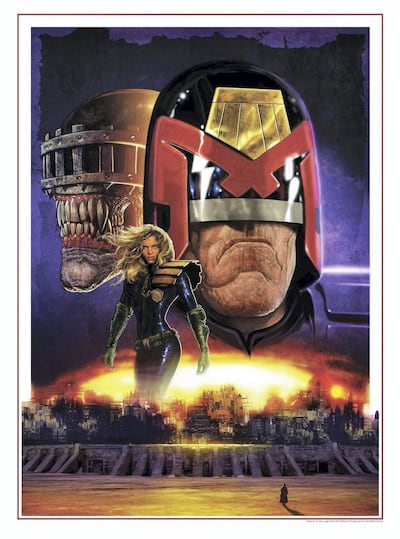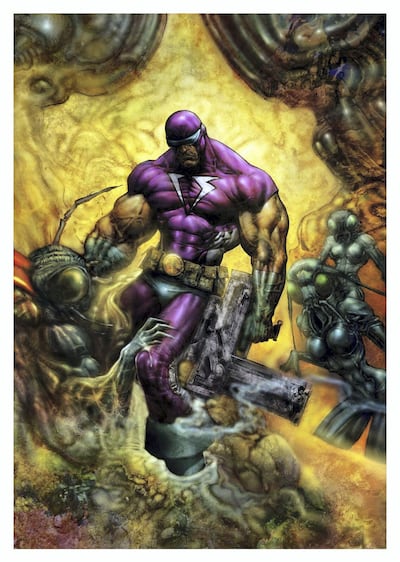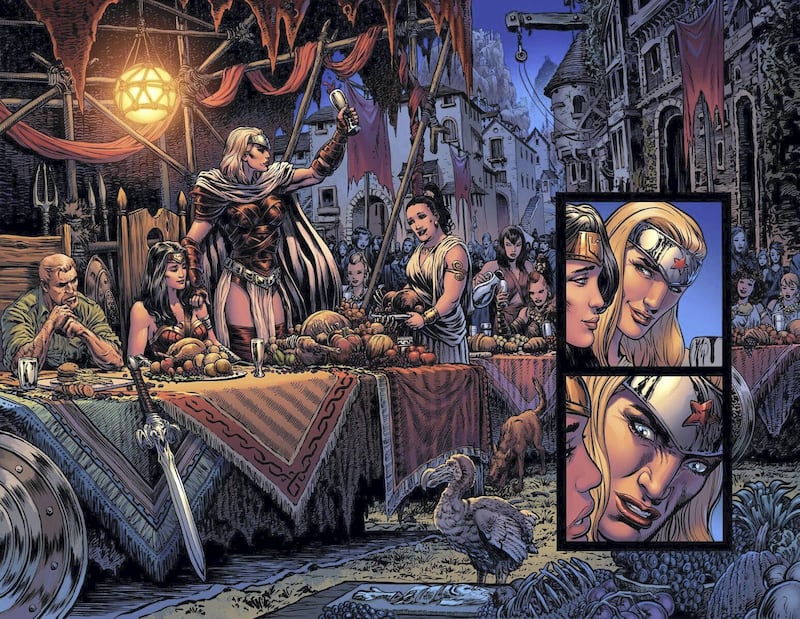Liam Sharp is a British comic-book artist who cut his teeth working for 2000 AD drawing Judge Dredd. He has subsequently worked for both Marvel and DC, contributing to X-Men, Hulk and Batman comics, and has just finished a 12-issue run on Wonder Woman for DC. His considerable contribution to the world of comics is being celebrated in an exhibition in his hometown of Derby, where work from the past three decades will be on show.
He is also exploring new platforms for storytelling with the Madefire app, which brings words and pictures to life through motion and sound, and uses VR (virtual reality) technology for a fully immersive experience.
What were your favourite comic strips when you were growing up?
A In the UK in the '70s, when I was growing up, superhero comics mainly came in two forms – black and white UK reprints or the pick of the bunch from whatever Marvel or DC comics the corner shops had in, and that could be a very random selection. Then of course there were the home-grown comics like 2000 AD. Rampage was all about The Hulk, but I also collected the Fantastic Four reprint for a while. The one I loved most of all, though, was the UK Star Wars magazine. It was weekly and had amazing back-up stories.
I was also a massive Conan fan, especially of work by John Buscema and Alfredo Alcala. I would pore over that work for hours on end. And there was a strip in Look and Learn magazine called The Trigan Empire that blew my mind.
And who were your greatest influences?
As I got older, I found myself drawn to comic work that was aimed at adults. It was fearless and a little unhinged. It was also beautiful. This was art I first found showcased in a book called Masters of Comic Book Art, then later tracked down in its original form. And lots of other fantasy and sci-fi art books.
In mainstream United States comics another revolution was going on, with Dave Gibbons and Alan Moore's Watchmen and Frank Miller and Bill Sienkiewicz's electrifying Electra Assassin. Miller also created his masterpiece in Batman: The Dark Knight, but before that he had honed his craft on the epic Euro-Asian fusion, Ronin.
The truth is I have been inspired and influenced by more artists than I can remember, and I imagine I always will be.
How did you get into your calling?
A little luck, but also bloody-mindedness. And my parents always supported me and knew from the age of seven that drawing was what I was going to do – though none of us knew exactly how. I don't know that I was specifically fixated on comics as much as imaginative art in general, but either way, when it became known to me that Don Lawrence – the artist of The Trigan Empire and Storm that I so loved – was looking for an assistant, and that he lived nearby, I put my best foot forward.
I tried out with him for a few weeks in the summer holidays when I was 17, and a year later I went full-time. Somewhere along the way Don realised he did not want to step back quite as much as he thought, and I realised I didn't want to have a career as somebody else's clone, no matter how much I loved their work, so Don started to help me evolve my own art, mostly by directly copying other art, then producing work 'in the style of' to see how I would carry over what I had learned. Within a year I was working for 2000 AD.
________________
Read more:
Middle Eastern hero Antar the Black Knight to take the world by storm
Fox teases X-Men spin-off - without the X-Men
Hollywood honours Marvel Comics legend Stan Lee
________________
What was the experience of working at 2000 AD during its glory years?
There were moments that really made me realise just how huge the reach of that comic was in the late 1980s. I was very young, and certainly felt like the rookie surrounded by these masters. But one day I was in HMV, the music store, on Oxford street. My mum was visiting, and she got to witness the girl at the counter looking at my credit card and saying "Liam Sharp? Not THE Liam Sharp of 2000 AD fame?" My legs almost gave way beneath me. It was the first time my name had seemed to mean anything to anybody.
Were you aware at the time that the comic was such a break from the past?
I don't think you ever quite realise what you are caught up in. I was talking to Bill Sienkiewicz about the times when Watchmen and Electra Assassin were blowing minds, and he said none of those guys had the slightest notion the books would become as important as they did. The first few issues were greeted with disdain and indifference. It can take a while for audiences and critics to catch up.
Who were your favourite 2000 AD characters?
Who doesn't love the Dark Judges? I really loved The Cursed Earth saga, and Judge Caligula, Mach Zero, Harlem Heroes, Ro-Busters and ABC Warriors … But I became a massive fan of Sláine. Glenn Fabry is one of the finest artists I have ever known, as was Mike McMahon before him. Then along came Simon Bisley, and everything changed again.
Judge Dredd has never seemed more prophetic, with an authoritarian president encouraging police officers to rough up suspects ...

Alan Grant and John Wagner always knew Dredd was an [anti-hero], but their genius was in somehow making us love him anyway. It was funny because it was so dark and unrelenting. Dredd is so intransigent and remorseless, and yet we still projected a heart there somewhere.
Why has Dredd not made as smooth a transition to cinema as some comic-book characters?
Because he's not a hero. The first movie tried to make him one. And they took his helmet off. But I think the second movie was great – except for the bike and the rest of the city, which didn't have that 2000 AD inventive craziness to my eyes. The recent film felt like an incredibly accomplished pilot for a great TV series, I thought. I hope we get to see more.
Do you think that the concept of the cinematic universes works?
I'm loving what Marvel and DC are doing. We're getting something that has never been done before, and when characters like Guardians of the Galaxy can get that kind of treatment it just stirs the inner child in me. We are so blessed to be able to see these incredible concepts up on the big screen.
I never quite understand why people get so angry. Comics have always evolved, and always circled back to become something akin to their base states. Time changes the world and everything we know, and comics – and comic-inspired movies – have to reflect that. The Hulk went through several versions before we got the best version in [Mark] Ruffalo, though I'm one of the few admirers of the Ang Lee movie.
You're currently drawing Wonder Woman: what did you think of the film?
I loved it. I think the heart of the movie was very close to what we were doing in the comic. There was a sort of kindred vibe, even though they are set in different times. It is a movie long overdue and it has shown the world who Diana is now, not what most people think she is – much more than a curvy model in a swimming suit.
Diana has always represented far more than she is given credit for. Of all the characters I have ever drawn, she has touched people in the most profound way. She has lent strength to people when their families, or friends or communities turned their backs. There's rarely a show I attend now when somebody doesn't thank me, and Diana, and all her creators, for literally saving their lives. I had no concept of that before I started drawing the book, and now I feel extremely honoured to be a part of this huge community. I take it all very seriously indeed.
Marvel or DC?
I just love great comics! I think DC has done some of the greatest comics of all time – more than Marvel in terms of pushing the envelope – but Marvel has a larger number of iconic characters. I could never pick one over the other though. What I can say is there's a buzz at DC right now amongst everybody – from the top down – that I have not felt since the early 1990s at Marvel. It's an amazing time to be here, and we're all having a lot of fun just creating. I feel like I'm riding a wave again, which hasn't happened for a very long time.
Is the beauty of the genre of comic-books that there are no constraints? Or do you feel sometimes that there are limits to what you can do?
With your own work you can do whatever you like. My magnum opus, Captain Stone is Missing, which you can read on the Madefire app, was co-created and co-written by my wife Christina [McCormack], and it is a love-letter in sequential form to the great comics of the '80s that inspired me. I threw everything I have at that, and am incredibly proud of it. When it comes to the icons we're custodians, and have to respect certain boundaries.

What advice would you give an aspiring Liam Sharp?
Don't burn bridges. Be civil at all times. Don't take on something if you can't deliver. Hit your deadlines. Listen to your peers, and to those that have inspired you. Be humble, be generous, be giving to those coming up behind you. Don't give up. Don't despair. Don't beat yourself up too much.
Judge Dredd to Wonder Woman – the work of Liam Sharp, runs until September 3 at Derby Museum and Art Gallery. See www.derbymuseums.org






